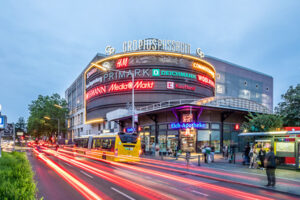By Matthew Burke
Another Christmas period has come and gone–the craziness of Black Friday, Cyber Monday, last Saturday before Christmas, Boxing Day sales, New Year sales whirled around the pool of measurable data. Omicron certainly created a few problems for retailers and shoppers alike, yet through it all one constant remains: the obsession with footfall.
Quite rightly perhaps, there is often a huge amount of focus on footfall performance. It was, after all, in many cases improving week after week, for some even equal to the 2019 rates. One would say this is cause for celebration–or is it?
Retailers and operators (and the media) seem fixated on footfall. It grabs headlines, is featured on news broadcasts, and sometimes analyzed on a weekly, daily, and even hourly basis. Yet if the last two years have taught us anything, it’s that the consumer behavior has changed dramatically, quickly, and with huge impact for many retailers, operators, and destinations. Business models have had to change and the confidence of both sides–consumers and businesses–has been rocked to its core.
Businesses have been desperate to attract customers back to their locations. And this is the core issue. They need customers, yet everyone is tracking footfall–absolute numbers. But isn’t this the wrong number to be focusing on, leading to potentially wrong commercial decisions?
If I was a retailer, I wouldn’t be asking “how much is footfall increasing?”. The question should rather be: “who is making up this footfall, why are they coming and is it right for my business?”.
Absolute volumes of footfall that we see reported in the press tell us one thing: volume. They don’t tell us the things that really matter. Who makes up this footfall (now), how valuable are they, where are they coming from and how often, are they my target customer, and should my business be in this specific location? In any given week, there is also likely going to be an overlap between different destinations.
Comparing footfall by region or across different asset types in itself won’t give true understanding and insight. The unspoken assumption is often that footfall make up is the same everywhere–it’s not. It varies by time of day, day of the week, season, and location.
Some businesses are now exploiting this very fact to a great extend. Take international city destinations like London, Paris, or Berlin as examples. Their footfall may be recovering, but they lack tourists and office workers, making their numbers fundamentally different from 2019.
After the lockdowns in the UK, older shoppers were more nervous about shopping than younger shoppers. Visiting frequency has changed, customer origin is different etc.
The takeaway from all this is simple. In a time of massive change, headline numbers are just that, a headline. What businesses need is real insight into who the customer really is, who matters most, whether this has changed and if it will change again. Only then will representatives make accurate and informed decisions, be that in one single, or across multiple markets. The answers and tools are out there, so take the time to get it right, ask the right questions, and get the right answers. This approach will make businesses gain real knowledge and insight on their customers, thus leading to a competitive advantage.





